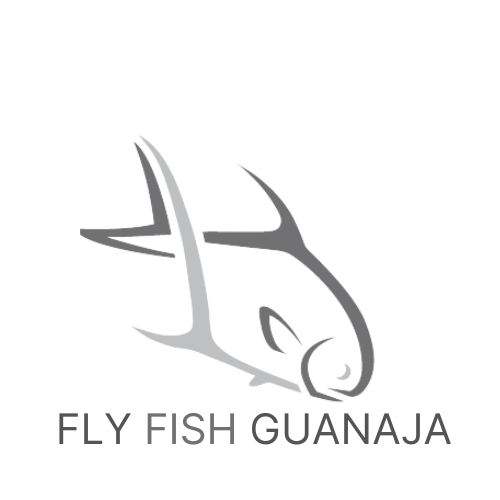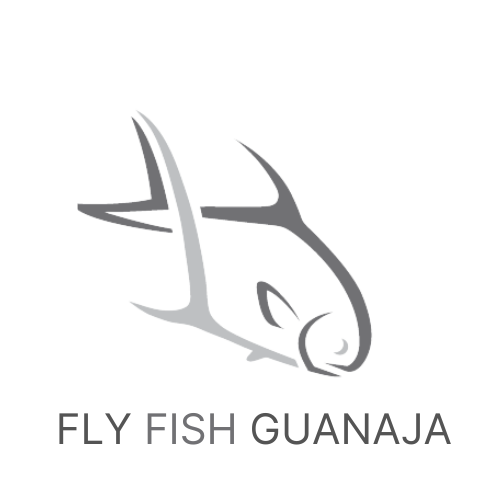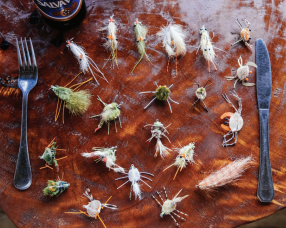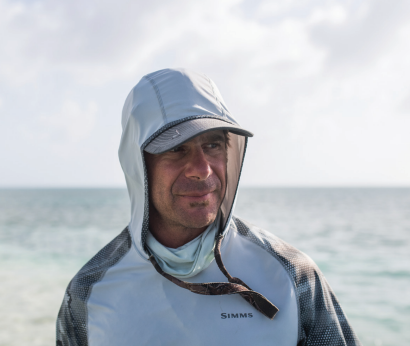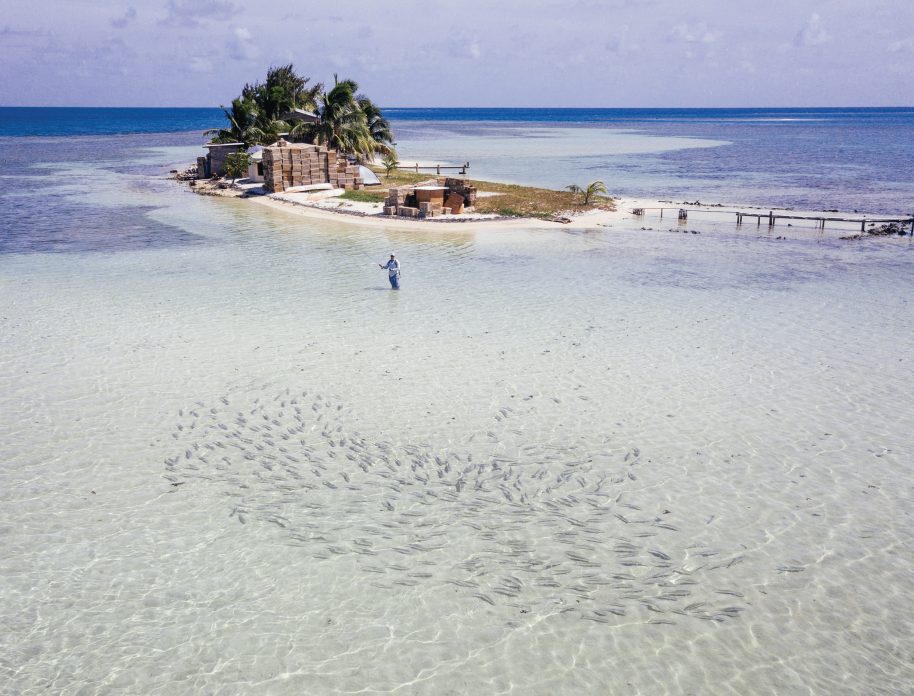For Serious Anglers Only….
An Outpost Camp for Serious Anglers Only by Schuyler Marshall
As seen in Destinations Magazine
Fish that have never seen a fly” is an old cliché, but one that seems to expand in the imagination at the same rate it dwindles in reality. For permit addicts, it usually evokes desert islands and empty horizon, the only other person in the picture standing 18 feet aft holding a pushpole and speaking Creole. Not many places are left that approximate that vision. One was recently found, however, with such a close resemblance that even the name and geography suggest an angler’s fantasy. Faraway Cayes is a system of reef, flats, and a few widely spaced cayes in the middle of the Caribbean. These tiny spits of sand are part of Honduras, a country whose colorful history tends more toward the dark side of the palette. Honduras was the original “banana republic,” so described in 1904 by the writer O. Henry, who had spent six months there running from the law back in Texas. More than a century later, the law in Honduras still resembles the Wild West. The nation has been a playground for Communist guerrillas, CIA operatives, and drug cartels, with a sprinkling of natural disasters and coups d’état. It remains one of the poorest countries in the Western Hemisphere.
Parts of mainland Honduras are simply “no-go” zones for outsiders. Do not attempt to pioneer fisheries in, say, the region of La Mosquitia, even though it contains the largest wilderness area in Central America and a great diversity of species. This swampy lowland jungle is occupied by indigenous peoples and cartels, although U.S. Special Forces were brought in just over a decade ago to help the Honduran government combat the latter. But despite the country’s dubious reputation, the ills of the mainland have had difficulty crossing over to the Bay Islands: Roatan, Guanaja, Utila, plus a number of smaller islands and cayes. Tourism has staked a viable claim in Roatan, a well-known scuba diving destination with dozens of hotels and resorts and more than a million visitors every year. A surprising number of foreign citizens and expats own homes there.
The attraction of the islands is due in part to the rich marine life surrounding them, but also to local culture that deliberately keeps its distance from the mainland. For instance, Spanish is the official language of Honduras, stemming from three centuries of Spanish rule before independence in 1821. But the islanders prefer to speak English, a nod to their roots as a British settlement that has become a status symbol of sorts over their countrymen on the mainland. Just last year, the mayor of Roatan campaigned to bring British rule back to the islands. Guanaja receives only a tiny fraction of the tourism and foreign investment compared to its larger neighbor to the west, Roatan. Fishing and lobstering provide a way of life on Guanaja. The deep-drop commercial fishing boats based on the island roam all the way to the eastern maritime boundary of Honduras, primarily harvesting snapper. On this route, they pass by and through the Faraway Cayes, and find protected anchorage there when weather chases them in from working the outer banks beyond. Lobstering families have camps on the few slivers of dry land, leaving thousands of traps stacked two stories high in some places during the off season. Though not interested in permit and bonefish, experienced watermen like these cannot help but notice the schools all over the flats of Faraway Cayes.
LOCAL KNOWLEDGE
When Steve Brown founded Fly Fish Guanaja (flyfishguanaja. com), naturally he sought out fishermen to train as guides. Several had worked on their families’ wide-ranging snapper boats or lobstering operations. Fly fishing proved a far better option. It brought larger and more regular paychecks, did not deplete fish stocks that were already in a troubling decline, and it was safer, less physically taxing, and much more fun. This new opportunity, combined with Brown’s uncommon impulse to improve the lives of those around him, quickly earned him the guides’ friendship and loyalty. Brown not only offered employment to guides, cooks, housekeepers, security guards, groundskeepers, ferrymen, and pilots, he treated them fairly. He trained a local to tie flies, setting her up with tools, materials, a website (guideflies.com), and a steady stream of customers who arrive every week to fish with Fly Fish Guanaja. Brown even earned the trust of Guanaja locals, no easy task for an outsider who set up a business in their backyard. They saw him helping heal the local environment. In 1998, Hurricane Mitch hit at peak intensity, razing nearly all of the homes and forests on Guanaja, including mangroves. Fly Fish Guanaja began operating a few years later, as residents struggled to rebuild and restore their island. Realizing this, Brown founded the student program Fish for Change, through which groups of teens each spend a week in Guanaja to fish and do community service work. Students collect trash and plant mangrove seedlings in areas wiped out by the storm, then learn to chase bonefish with a fly rod. The program has since expanded to Mexico and the Bahamas. Fly Fish Guanaja was an early adopter of Costa’s “kick plastic” movement, eliminating single-use water bottles in favor of durable reusable bottles. As a fishing community, locals also appreciated what catch-and-release would mean for the island. The guides swear that even now, over a decade later, the fishing continues to improve. Having accepted Brown as an ally and doer of good, the guides shared their intel on the Faraway Cayes with him. He heard the reports from enough independent sources that he had to see it for himself, the distance notwithstanding. One of the snapper boats ferried Brown on his first trip out there. It is possible that the idea of going by helicopter occurred to him on the 24- hour trip from Guanaja. In any event, Brown personally verified the sensational fish reports. He also surveyed one of his guide’s lobstering camps as a potential helicopter landing pad, and envisioned a base for a fly-fishing operation there. Outfitting trips so far out was already going to be a herculean logistical undertaking, and at first the Honduran government did not make it any easier. The length of the heli flight requires refueling near the Faraway Cayes for the return trip. Smuggling also demands fuel, however, and therefore authorities kept refusing to grant a permit for a fuel depot. Given that trafficking routes ran through the Faraway Cayes not too long ago, they suspected that fly fishing was a cover for more of the same. It was too hard to believe that anglers would pay big money to fly so far out by helicopter to catch fish, only to let them all go. But Brown persisted. At the same time, he teamed up with the scientific and conservation communities. The organization Mar Alliance studies marine life and habitat on the Mesoamerican reef system that includes the Faraway Cayes. Their researchers had identified a number of concerns in Honduran waters—par - ticularly the overfishing of sharks, rays, and lobster—but data was sparse. Factors like remoteness, security, and lack of political will stood in the way of further study. Brown turned out to be the link to solving these issues. The guides had faith in Brown and his support for Mar Alli - ance, so the organization was given use of the family lobstering camp that would also double as a fly-fishing lodge. Karma worked quickly, as the Honduran government soon permitted helicopter access to Faraway Cayes. With scientists and fly fishers both seek - ing to operate there, however, the government went way beyond simply granting approvals. It increased navy and coast guard pa - trols in the area, and stationed several navy servicemen at the camp. This unprecedented support came all the way from the nation’s president, and it allowed both scientists and fly fishers to operate without constantly looking over their shoulders.
CAPT. JIMMY
Next, Brown enlisted a helicopter company that regularly uses its six-seat Bell 407 to carry Hollywood actors and TV ex - ecutives. A snapper fishing captain also signed on to support the operation. Cap - tain Jimmy was as grateful for an alternative to com - mercial fishing as the guides were. He was not only con - tending with the effects of overfishing, he had been deeply scarred by the dan - gers of the work. His father was killed when a freight - er running at night plowed through his snapper boat. Now Capt. Jimmy provides communications and added safe - ty, transports supplies, keeps ice, stocks the kitchen with fresh seafood, and ferries anglers and skiffs over open water to more distant flats. So, against what had to have been daunting odds, a team of guides, staff, captains, pilots, scientists, conservationists, military, and even political figures came together. Even with the benefit of hindsight, there is no way to know how much of this convergence was due to luck and circumstances or sheer force of will.
When Brown talks about how his outlandish idea became a functioning saltwater heli-fishing program, he gives all the credit to the team. But it is hard not to see Brown as both the hub and power source, drawing others together and propelling them all forward. With the pieces in place, a few loyal clients and friends helped Brown prove the concept and continue to explore the fishery in the spring of 2017. The resulting reports rippled through the permit fishing cult, filling up seats on the heli for the first “official” season in 2018. The backstory of the new fishery came to life in the short film Beyond the Horizon, which was selected for the 2018 Fly Fishing Film Tour and Telluride Mountain Film Festival. The ripples swelled and spread, and the 2018 and 2019 seasons lived up to the billing. The refrain “best permit fishing I’ve ever seen” has gone from anecdotal to statistically significant through consistent repetition by anglers bold and lucky enough to go. To temper expectations a bit, uneducated permit are still permit. Faraway Cayes anglers are not losing count of fish landed. Permit are tough to catch, even where they have not seen a fly, and each one brought to hand will be remembered for a lifetime. While it’s not easy, the numbers of permit at Faraway Cayes translate into lots and lots of shots. These fish own the shallows, tailing all over knee-deep turtle grass flats when the tide is right. Shots at tails while wading are the most difficult and potentially most rewarding, and therefore prized by permit junkies. The Faraway Cayes provide plenty of such chances. The permit here also exhibit a behavior that is unheard of elsewhere, but accounts for many higher-percentage opportunities. Lots of eagle rays glide close to the surface over slightly deeper flats. The permit use them as sun shades, gluing themselves to the bellies of the rays and virtually disappearing. But when a fly lands in front of a ray, more often than not a permit materializes to chase it down. Shots at rays are productive not only because they yield aggressive permit, but because rays are easier to pick up for eyes not adjusted to seeing into the water at a new locale. Countless bonefish and a healthy population of triggerfish also beckon, although the typical angler may not be as enthused about taking a helicopter over open ocean to catch bonefish. Permit clearly bring people out, but those other targets help make the trip worth it. Unlike most in Central America, Faraway Cayes bones have the size to shed daylight on backing that normally stays tightly wrapped. A few of the bones reach double digits. Gray triggerfish tail over many of the same flats as permit and willingly eat flies, a bonus that does not divert the hunt for the more coveted species. Of course, all fly-fishing lodges tell plenty of fish stories, true or not. The real proof lies in rebookings. Most clients are returning to Faraway Cayes, even those not accustomed to staying in a rustic fish camp. Fishing lodges that succeed at this price point typically offer much cushier digs. But the fishing and the tranquility, along with the obvious logistical challenges of operating so far out, make it is easy to forgive whatever the camp lacks in luxury.
Clients sleep in spacious yurt tents with ceiling fans and actual beds. The cooks have received far more compliments than complaints; the never-ending supply of fresh lobster, crab, and fish makes up for the difficulty of camp cooking with makeshift equipment and infrequent supply runs for fresh produce. Each new season has also brought upgrades to the camp. There was no running water during the exploratory season, but a full bathroom was installed last year. Thousands of idle lobster traps used to double as building blocks for kitchen and dining enclosures, and as foundations for the yurts. In 2019, all of the traps have been removed, and solid decking elevates the yurts. A gathering area and dining room that can keep out weather replaced a room created from slotted traps. Although the caye is barely an acre of sand, several palm and pine trees flourish. They block the intense sun by day and, after the generator is turned off at night, whisper to tired anglers in harmony with waves lapping a few feet outside the tent. Though camp is rustic, few anglers would change it after spending a week there. The escape from phone, Wi-Fi, television, traffic, and all other constant distractions turns out to be the best amenity of all. Given their ultra-remote location in a region with a troubled past, the Faraway Cayes are not for everyone, and especially not for the timid. But the limited program could not handle the masses anyway. The capacity of the heli limits space to just five anglers per week March through early June.
While there has been no sign that the flats need to be rested during that time, Brown insists on a three-weeks-on, one-week-off schedule. He’s one of the rare outfitters who turns down an easy buck in favor of his long-term vision, and he wants to be sure that every angler experiences pristine flats. All of that is to say, only about 50 to 60 fly fishers per year can go see it for themselves. As a new, ambitious program tapping into a fishery on the ragged edge, its longevity remains to be seen. But for now at least, the Faraway Cayes gives hope to the Hondurans making it possible, and to the collective angling subconscious that depends on there still being places to explore.
by Schuyler Marshall is a travel consultant with Tailwaters Fly Fishing company.
